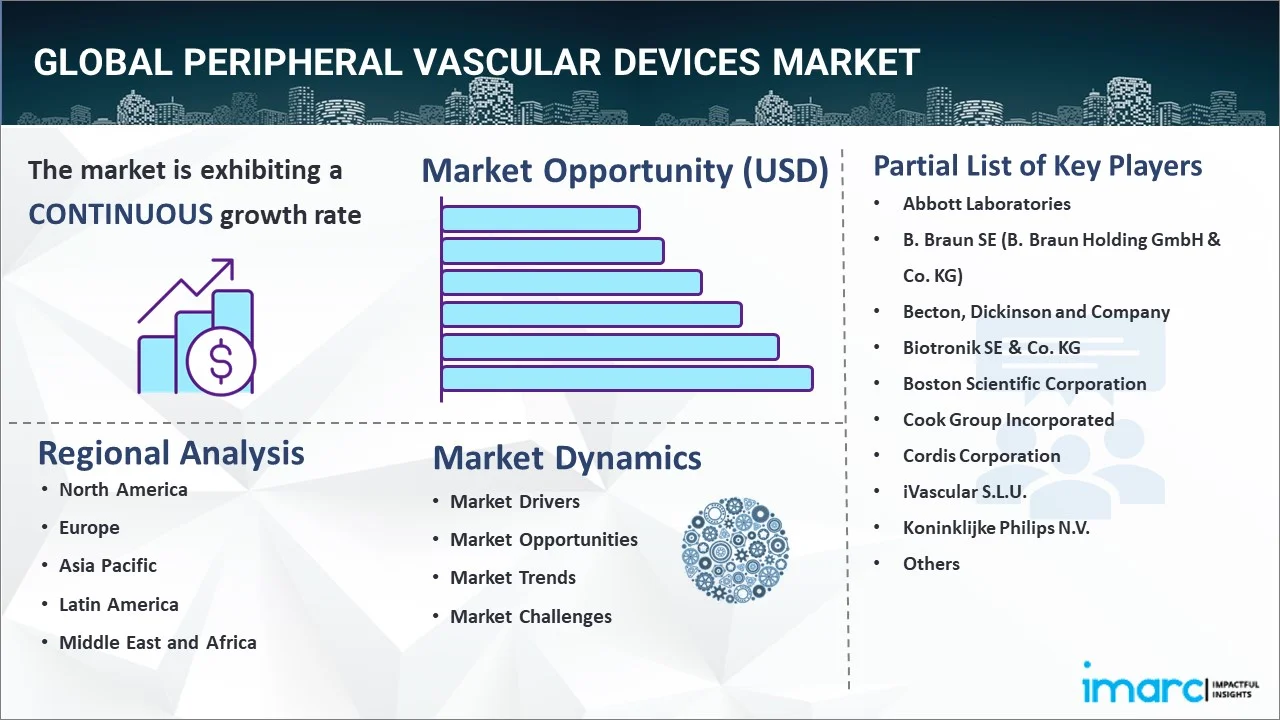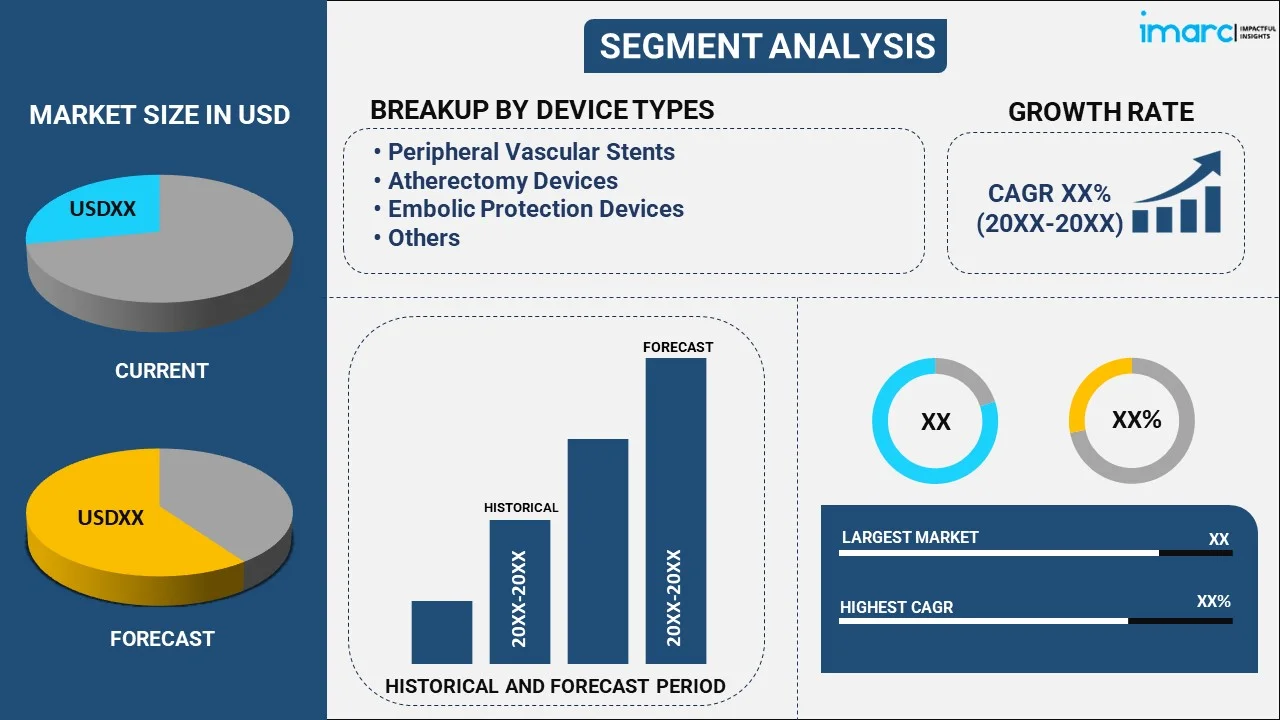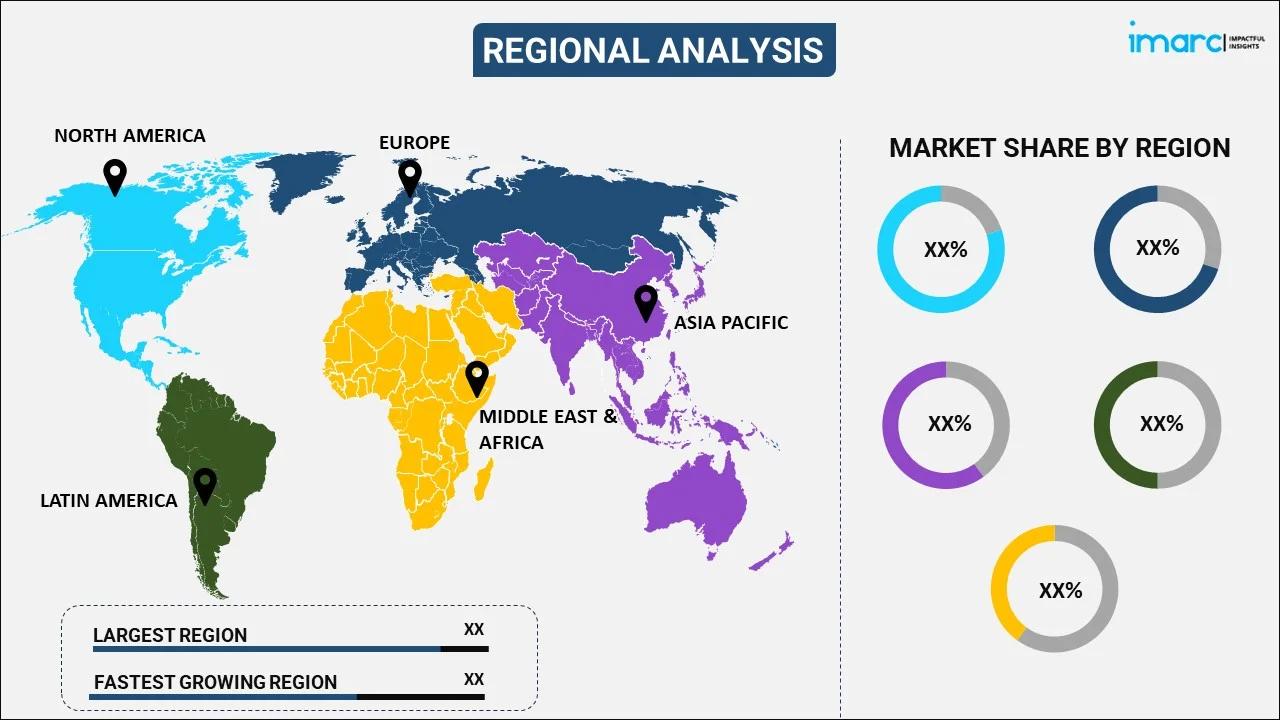
Peripheral Vascular Devices Market Report by Device Type (Peripheral Vascular Stents, Peripheral Transluminal Angioplasty (PTA) Balloon Catheters, Peripheral Transluminal Angioplasty (PTA) Guidewires, Atherectomy Devices, Embolic Protection Devices, Inferior Vena Cava Filters, and Others), End User (Hospitals and Clinics, Ambulatory Care Centers, Specialty Clinics, and Others), and Region 2025-2033
Peripheral Vascular Devices Market Size:
The global peripheral vascular devices market size reached USD 12.3 Billion in 2024. Looking forward, IMARC Group expects the market to reach USD 20.7 Billion by 2033, exhibiting a growth rate (CAGR) of 5.64% during 2025-2033. The market growth is significantly propelled by ongoing innovations in minimally invasive procedures and amplifying prevalence of cardiovascular disorders. Moreover, demand for atherectomy devices, stents, and angioplasty balloons is heightening as healthcare providers emphasize on enhancing patient outcomes, driving substantial market expansion across medical industry.
|
Report Attribute
|
Key Statistics
|
|---|---|
|
Base Year
|
2024
|
|
Forecast Years
|
2025-2033
|
|
Historical Years
|
2019-2024
|
|
Market Size in 2024
|
USD 12.3 Billion |
|
Market Forecast in 2033
|
USD 20.7 Billion |
| Market Growth Rate 2025-2033 | 5.64% |
Peripheral vascular disease (PVD) is a circulatory condition caused due to the narrowing, blockage, or spasms in the blood vessels located outside the heart and brain. Such occurrences reduce the blood flow through the vessels, resulting in weakness, pain, gangrene, hair loss on the legs, numbness, and muscle heaviness. Peripheral vascular devices, such as angioplasty catheters, peripheral guidewires, vena cava filters, stent grafts, and embolic protection devices (EPD), are used to treat artery blockages and narrowing. These blockages, particularly found in the peripheral vasculature, are caused by plaque build-up, which limits the blood vessels and reduces blood flow to the body parts. Peripheral vascular devices are safe, minimize the risk of infection and irritation, improve blood flow, and supply oxygenated blood through arteries.

Peripheral Vascular Devices Market Trends:
Heightening Demand for Minimally Invasive Procedures
The global peripheral vascular devices market is witnessing an escalating demand for minimally invasive procedures, primarily driven by the requirement for cost-effectiveness, minimized recovery times, and reduced complication rates. Devices like atherectomy systems, stents, and angioplasty balloons are rapidly gaining momentum due to their capability to treat peripheral artery diseases with reduced trauma to the patient. Moreover, as healthcare patients and providers are increasingly opting for such procedures, innovations in technology are rapidly growing to improve the accuracy and efficacy of such devices. In addition, this trend is boosting the market expansion, particularly as healthcare systems are currently focusing on patient-specific treatments and successful outcomes. As per industry reports, the minimally invasive surgery devices market is anticipated to expand from USD 14.06 billion in 2023 to USD 28.483 billion by the year 2032.
Technological Innovations in Vascular Devices
The peripheral vascular devices market analysis indicates that constant technological advancements are significantly steering the global market expansion. Innovations, such as enhanced imaging techniques, drug-coated balloons, and bioresorbable stents, are improving the efficacy of treatments for peripheral vascular diseases. According to a research article published in the journal Cardiovascular Interventions, in May 2023, drug-coated balloons (DCBs) attained a 5-year freedom from reintervention procedures of 58% for in-stent restenosis, a condition associated with peripheral vascular diseases. Moreover, such advancements facilitate more accurate interventions, enhance patient outcomes, and lower the requirement for repeat procedures. In addition, the increasing incorporation of digital health solutions, such as data analytics and remote monitoring, is enabling better management of chronic vascular disorders. Furthermore, as manufacturers are heavily investing in research and development projects to bring leading-edge solutions to the market, the overall need for upgraded peripheral vascular devices is stably escalating.
Rising Prevalence of Peripheral Artery Disease (PAD)
The peripheral vascular devices market research indicates that the amplifying prevalence of peripheral artery disease (PAD) is a crucial driver of the global market. With an elevation in aging population and the heightening incidents of risk factors, such as smoking, diabetes, and hypertension, PAD cases are gradually becoming more prevalent globally. According to the International Diabetes Federation, the number of individuals suffering with diabetes will elevate to 643 million by 2030 and 783 million by the year 2045. Moreover, this accelerating patient pool is bolstering the demand for efficient vascular devices to treat as well as manage the condition. In addition, as awareness of PAD is notably fueling worldwide among both patients and healthcare providers, early diagnosis and intervention are also surging. Resultantly, there is a proliferating market for angioplasty balloons, stents, and various other devices developed to mitigate arterial blockages and enhance circulation, substantially contributing to the peripheral vascular devices market growth.
Peripheral Vascular Devices Market Segmentation:
IMARC Group provides an analysis of the key trends in each segment of the market, along with forecasts at the global, regional, and country levels for 2025-2033. Our report has categorized the market based on device type and end user.
Breakup by Device Type:

- Peripheral Vascular Stents
- Peripheral Transluminal Angioplasty (PTA) Balloon Catheters
- Peripheral Transluminal Angioplasty (PTA) Guidewires
- Atherectomy Devices
- Embolic Protection Devices
- Inferior Vena Cava Filters
- Others
Peripheral vascular stents accounts for the majority of the market share
The report has provided a detailed breakup and analysis of the market based on the device type. This includes peripheral vascular stents, peripheral transluminal angioplasty (PTA) balloon catheters, peripheral transluminal angioplasty (PTA) guidewires, atherectomy devices, embolic protection devices, inferior vena cava filters, and others. According to the report, peripheral vascular stents represented the largest segment.
Breakup by End User:
- Hospitals and Clinics
- Ambulatory Care Centers
- Specialty Clinics
- Others
Hospitals and clinics hold the largest share of the industry
A detailed breakup and analysis of the market based on the end user have also been provided in the report. This includes hospitals and clinics, ambulatory care centers, specialty clinics, and others. According to the report, hospitals and clinics accounted for the largest market share.
Breakup by Region:

- North America
- United States
- Canada
- Asia-Pacific
- China
- Japan
- India
- South Korea
- Australia
- Indonesia
- Others
- Europe
- Germany
- France
- United Kingdom
- Italy
- Spain
- Russia
- Others
- Latin America
- Brazil
- Mexico
- Others
- Middle East and Africa
North America leads the market, accounting for the largest peripheral vascular devices market share
The report has also provided a comprehensive analysis of all the major regional markets, which include North America (the United States and Canada); Europe (Germany, France, the United Kingdom, Italy, Spain, Russia, and others); Asia Pacific (China, Japan, India, South Korea, Australia, Indonesia, and others); Latin America (Brazil, Mexico, and others); and the Middle East and Africa. According to the report, North America represents the largest regional market for peripheral vascular devices.
Competitive Landscape:
The report has also provided a comprehensive analysis of the competitive landscape in the global peripheral vascular devices market. Detailed profiles of all major companies have also been provided. Some of the companies covered include:
- Abbott Laboratories
- B. Braun SE (B. Braun Holding GmbH & Co. KG)
- Becton, Dickinson and Company
- Biotronik SE & Co. KG
- Boston Scientific Corporation
- Cook Group Incorporated
- Cordis Corporation
- iVascular S.L.U.
- Koninklijke Philips N.V.
- Medtronic plc
- Terumo Medical Corporation
Kindly note that this only represents a partial list of companies, and the complete list has been provided in the report.
Peripheral Vascular Devices Market News:
- In April 2024, Abbott announced the receival of FDA approval for an innovative, first-of-its-kind Esprit BTK Everolimus Eluting Resorbable Scaffold System, a dissolvable stent specially designed for below-the-knee chronic limb-threatening ischemia disease, an acute form of peripheral artery disease.
- In May 2024, BD Life Sciences announced the commencement of a clinical trial for its self-expanding vascular covered stent, designed for peripheral arterial disease and coated with fluoropolymer.
Peripheral Vascular Devices Market Report Scope:
| Report Features | Details |
|---|---|
| Base Year of the Analysis | 2024 |
| Historical Period | 2019-2024 |
| Forecast Period | 2025-2033 |
| Units | Billion USD |
| Scope of the Report | Exploration of Historical Trends and Market Outlook, Industry Catalysts and Challenges, Segment-Wise Historical and Future Market Assessment:
|
| Device Types Covered | Peripheral Vascular Stents, Peripheral Transluminal Angioplasty (PTA) Balloon Catheters, Peripheral Transluminal Angioplasty (PTA) Guidewires, Atherectomy Devices, Embolic Protection Devices, Inferior Vena Cava Filters, Others |
| End Users Covered | Hospitals and Clinics, Ambulatory Care Centers, Specialty Clinics, Others |
| Regions Covered | Asia Pacific, Europe, North America, Latin America, Middle East and Africa |
| Countries Covered | United States, Canada, Germany, France, United Kingdom, Italy, Spain, Russia, China, Japan, India, South Korea, Australia, Indonesia, Brazil, Mexico |
| Companies Covered | Abbott Laboratories, B. Braun SE (B. Braun Holding GmbH & Co. KG), Becton, Dickinson and Company, Biotronik SE & Co. KG, Boston Scientific Corporation, Cook Group Incorporated, Cordis Corporation, iVascular S.L.U., Koninklijke Philips N.V., Medtronic plc, Terumo Medical Corporation, etc. |
| Customization Scope | 10% Free Customization |
| Post-Sale Analyst Support | 10-12 Weeks |
| Delivery Format | PDF and Excel through Email (We can also provide the editable version of the report in PPT/Word format on special request) |
Key Benefits for Stakeholders:
- IMARC’s industry report offers a comprehensive quantitative analysis of various market segments, historical and current market trends, market forecasts, and dynamics of the peripheral vascular devices market from 2019-2033.
- The research report provides the latest information on the market drivers, challenges, and opportunities in the global peripheral vascular devices market.
- The study maps the leading, as well as the fastest-growing, regional markets. It further enables stakeholders to identify the key country-level markets within each region.
- Porter's five forces analysis assists stakeholders in assessing the impact of new entrants, competitive rivalry, supplier power, buyer power, and the threat of substitution. It helps stakeholders to analyze the level of competition within the peripheral vascular devices industry and its attractiveness.
- The competitive landscape allows stakeholders to understand their competitive environment and provides insight into the current positions of key players in the market.
Key Questions Answered in This Report
The global peripheral vascular devices market was valued at USD 12.3 Billion in 2024.
We expect the global peripheral vascular devices market to exhibit a CAGR of 5.64% during 2025-2033.
The rising demand for peripheral vascular devices, such as angioplasty catheters, vena cava filters, stent grafts, etc., as they are safe, minimize the risk of irritation, improve blood flow, supply oxygenated blood through arteries, etc., is primarily driving the global peripheral vascular devices market.
The sudden outbreak of the COVID-19 pandemic had led to postponement of elective peripheral vascular disease treatments to reduce the risk of the coronavirus infection upon hospital visits and interaction with medical equipment, thereby negatively impacting the global market for peripheral vascular devices.
Based on the device type, the global peripheral vascular devices market has been segmented into peripheral vascular stents, Peripheral Transluminal Angioplasty (PTA) balloon catheters, Peripheral Transluminal Angioplasty (PTA) guidewires, atherectomy devices, embolic protection devices, inferior vena cava filters, and others. Among these, peripheral vascular stents currently hold the majority of the total market share.
Based on the end user, the global peripheral vascular devices market can be divided into hospitals and clinics, ambulatory care centers, specialty clinics, and others. Currently, hospitals and clinics exhibit a clear dominance in the market.
On a regional level, the market has been classified into North America, Asia-Pacific, Europe, Latin America, and Middle East and Africa, where North America currently dominates the global market.
Some of the major players in the global peripheral vascular devices market include Abbott Laboratories, B. Braun SE (B. Braun Holding GmbH & Co. KG), Becton, Dickinson and Company, Biotronik SE & Co. KG, Boston Scientific Corporation, Cook Group Incorporated, Cordis Corporation, iVascular S.L.U., Koninklijke Philips N.V., Medtronic plc, and Terumo Medical Corporation.
Need more help?
- Speak to our experienced analysts for insights on the current market scenarios.
- Include additional segments and countries to customize the report as per your requirement.
- Gain an unparalleled competitive advantage in your domain by understanding how to utilize the report and positively impacting your operations and revenue.
- For further assistance, please connect with our analysts.
 Inquire Before Buying
Inquire Before Buying
 Speak to an Analyst
Speak to an Analyst
 Request Brochure
Request Brochure
 Request Customization
Request Customization




.webp)




.webp)












